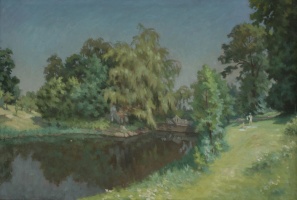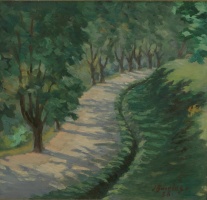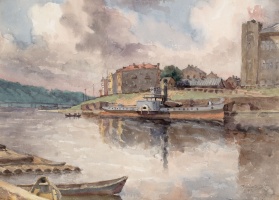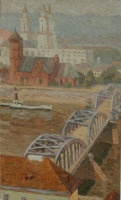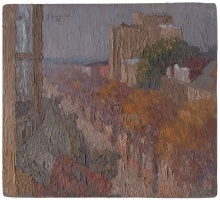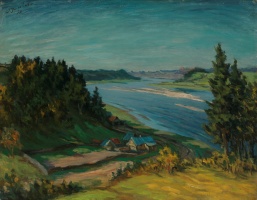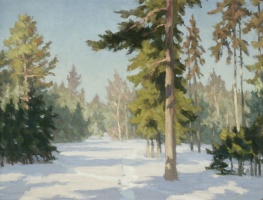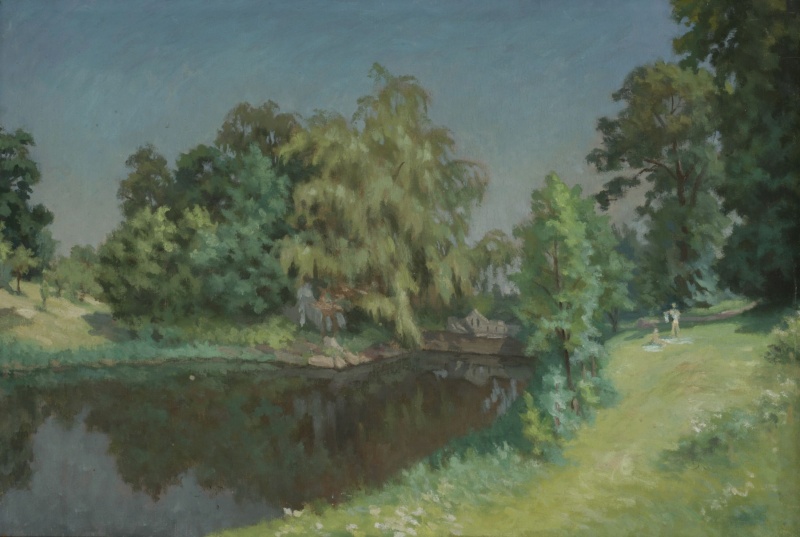

A pond at Linkuva
| Author: | Jonas Buračas (1898–1977) |
Jonas Buračas (1898–1977). Jonas Buračas, a painter and watercolourist, was born on 8 July 1898 in Sidarai village, Radviliškis district. In 1920–1921 he attended the Teachers’ Seminary in Šiauliai and pedagogicalcourses, and in 1921–1927 he attended Kaunas drawing courses and studied at theKaunas School of Art. He and his brother Balys travelled around Lithuania collecting folklore and folk art. Throughout his wholelife J. Buračas’ love for national culture, history and ethnography remained paramount. During 1929–1930 he improved his skills individually in Paris: he attended museums, art galleries and various studios. He liked impressionism and pointillism – the influence of which is vivid in the artist’s works of that period. In his creations J. Buračas immortalises numerous castle-mounds and monuments of architecture and nature, which present not only artistic but also historical, archaeological and ethnographic value. His paintings and water colours are all masterful and rendered in compliance with the requirements of painting techniques.
Jonas Buračas was an ascetic artist and in the name of art, he rejected all the simple joys of life, even having a family. His most important purpose was to immortalise the beauty of the country. Along with the artistic value, his works bear historic and ethnographic value. The artist painted historically significant places: many mounds, monuments of the historic architecture of Vilnius and Kaunas, landscapes now sunk at the bottom of the Kaunas Sea, the Saulės battlefield and other panoramic and fragmental landscapes of the country. His pictures are not the landscapes of the mood or expression of the author’s experiences, rather they are masterfully painted entities of nature with their characteristic lighting and the breathing rhythm of nature itself – within every span of time in the day and night and every season of the year. The painter diligently observed the artistic modifications in the proportions of trees, land and water, depending on the shifting movement of the sky and differences in lighting. He painted as if desperate to preserve the unique beauty of the homeland for future generations.
Source: Valiunas Ellex (LAWIN until 2015) art album: THE WORLD OF LANDSCAPES I (2010). Compilers Nijolė Tumėnienė, Dalia Tarandaitė, Jurgita Semenauskienė. Text author Nijolė Tumėnienė.

Jonas Buračas (1898–1977). Jonas Buračas, a painter and watercolourist, was born on 8 July 1898 in Sidarai village, Radviliškis district. In 1920–1921 he attended the Teachers’ Seminary in Šiauliai and pedagogicalcourses, and in 1921–1927 he attended Kaunas drawing courses and studied at theKaunas School of Art. He and his brother Balys travelled around Lithuania collecting folklore and folk art. Throughout his wholelife J. Buračas’ love for national culture, history and ethnography remained paramount. During 1929–1930 he improved his skills individually in Paris: he attended museums, art galleries and various studios. He liked impressionism and pointillism – the influence of which is vivid in the artist’s works of that period. In his creations J. Buračas immortalises numerous castle-mounds and monuments of architecture and nature, which present not only artistic but also historical, archaeological and ethnographic value. His paintings and water colours are all masterful and rendered in compliance with the requirements of painting techniques.
Jonas Buračas was an ascetic artist and in the name of art, he rejected all the simple joys of life, even having a family. His most important purpose was to immortalise the beauty of the country. Along with the artistic value, his works bear historic and ethnographic value. The artist painted historically significant places: many mounds, monuments of the historic architecture of Vilnius and Kaunas, landscapes now sunk at the bottom of the Kaunas Sea, the Saulės battlefield and other panoramic and fragmental landscapes of the country. His pictures are not the landscapes of the mood or expression of the author’s experiences, rather they are masterfully painted entities of nature with their characteristic lighting and the breathing rhythm of nature itself – within every span of time in the day and night and every season of the year. The painter diligently observed the artistic modifications in the proportions of trees, land and water, depending on the shifting movement of the sky and differences in lighting. He painted as if desperate to preserve the unique beauty of the homeland for future generations.
Source: Valiunas Ellex (LAWIN until 2015) art album: THE WORLD OF LANDSCAPES I (2010). Compilers Nijolė Tumėnienė, Dalia Tarandaitė, Jurgita Semenauskienė. Text author Nijolė Tumėnienė.






